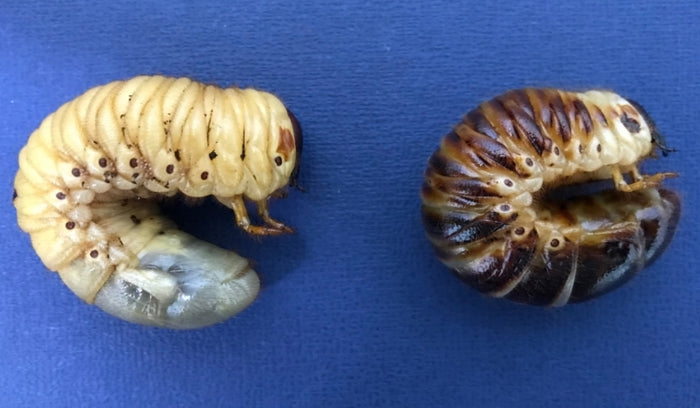🚩 These Diseases Are Common in Insect Farms

⚠️ Nudivirus Infection (Photo courtesy of Korean website)
Pathogen: Oryctes rhinoceros nudivirus
Cause: Occurs when larvae ingest contaminated substrate
Characteristics: Has a long incubation period before death
Symptoms:
• Early stage: The skin turns milky white and the lower abdomen becomes swollen
• Mid/Late stage: The swollen abdomen becomes soft and the larva climbs to the surface and dies
• After death: The body turns dark brown as internal decay begins
Action:
• Remove and incinerate infected larvae immediately to prevent spread
• Disinfect containers and tools thoroughly
• Replace with clean substrate and maintain good hygiene to prevent further infections
 ⚠️ Bacterial Disease (Soft Body Syndrome) (Photo courtesy of Korean website)
⚠️ Bacterial Disease (Soft Body Syndrome) (Photo courtesy of Korean website)
Pathogen: Serratia entomophila
Cause: Occurs when larvae ingest contaminated substrate
Characteristics: Highly lethal, almost always fatal once infected
Symptoms:
• Early/Mid stage: The body becomes transparent and loses its shine
• Late stage: The body softens, becomes jelly-like, and the larva climbs to the surface and dies
• After death: The body turns dark brown and rots internally
Action:
• Remove and burn infected larvae immediately
• Disinfect the container and all equipment
• Replace with clean substrate to stop the spread

 ⚠️ Green/White Mold Disease (Metarhizium Infection) (Photo courtesy of Korean website)
⚠️ Green/White Mold Disease (Metarhizium Infection) (Photo courtesy of Korean website)
Pathogen: Metarhizium anisopliae / Beauveria bassiana
Cause: Poor hygiene, leftover food, or high heat/humidity — above 28°C (82.4°F) and 70% RH
Characteristics: Has the longest incubation period among mold-related diseases
Symptoms:
• Around day 8 post-infection, large dark patches appear on the larval skin, followed by death
• Dead larvae become stiff and develop deep green mold spores (conidia) on the skin
Action:
• As soon as infection is confirmed, seal the container and remove it from your rearing area to avoid spore spread
• Disinfect the entire container and contents thoroughly
• Dispose of it by incineration
📌 Even if other larvae in the same container show no symptoms, do not reuse the substrate or raise them further, discard everything.


⚠️ Black Spot Disease (Photo courtesy of Japanese website Queen Beetles)
Cause: Exact cause is unknown
Suspected factors include excessive stress, fungal infection (Metadium-type mold), or even genetic predisposition
Symptoms:
• Black spots appear on the body
• In severe cases, the spots may spread throughout the body and lead to death
• Survival depends on the individual's physical strength or immunity
- If it occurs in the head capsule or L1 larvae, it is fatal
- But in most cases, larvae grow and pupate normally
Action:
• Keep larvae individually housed on clean substrate to prevent spread of infection.



⚠️ Mites
(Photo courtesy of Korean and Japanese websites: ドルクス赤羽&ダイナステス赤羽 / shiho)
Cause: Unhygienic substrate or contaminated rearing environment
Symptoms:
Mites feed on the insect’s bodily fluids, which can result in:
• Stunted growth
• Weight loss
• Reduced activity
• Shortened lifespan
Action:
• Remove visible mites from the body using a soft brush or rinse them off gently with water
• Since mites often originate from the substrate, sterilize or freeze the substrate before use to kill any eggs or mites hiding within
